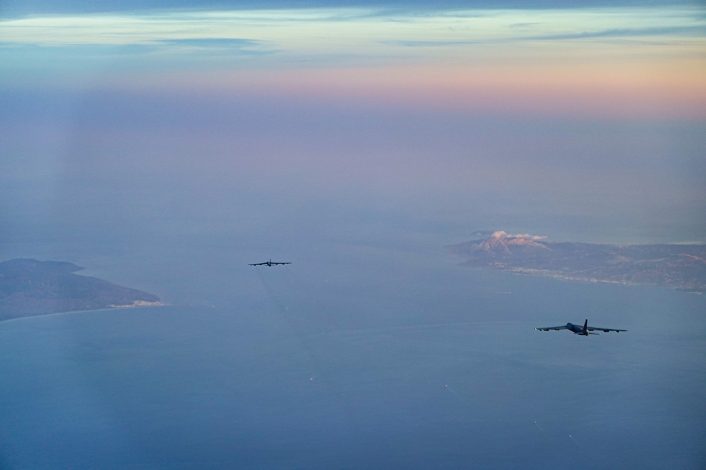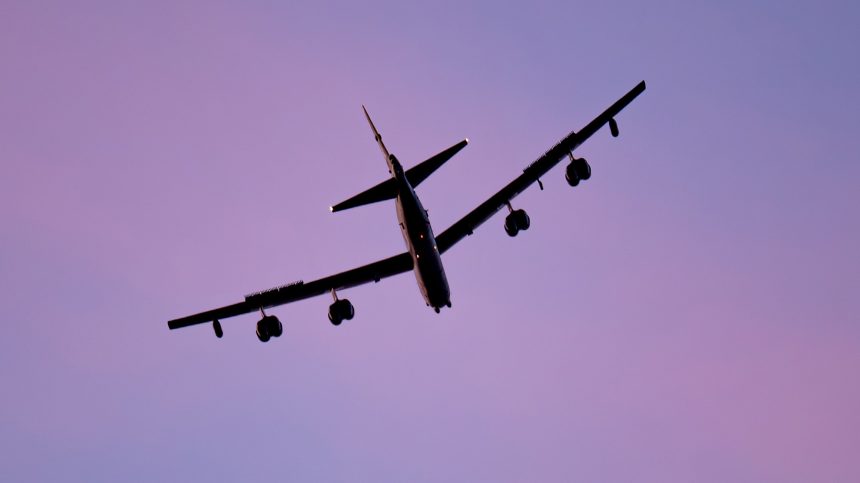The first European BTF deployment of the new financial year kicked off at Morón Air Base, Spain, on Nov. 8 with the arrival of three B-52 Stratofortress strategic bombers.
Three aircraft from the 2nd Bomb Wing (BW) at Barksdale Air Force Base, Louisiana, transited across the Atlantic as CAGER 11, 12, and 13, supported by U.S. based KC-46 Pegasus and KC-135 Stratotanker refueling aircraft.
Part of a routine and pre-planned Bomber Task Force (BTF) deployment, the bombers will use Morón as a forward staging post for a variety of missions across Europe, Africa, and the Middle East. These have previously included exercises involving live munitions, extensive co-operation with allied forces, and the occasional flypast for public ceremonies worked into existing flight plans.
According to the official U.S. Air Force press release, these missions will see crews “simulating operations in complex, high-threat airspace”, training on “key elements of the find, fix, track and target process”. It adds: “As aircrews practice these skills, they simultaneously train against simulated ground and air-based threats designed to deny their freedom of maneuver, requiring them to act decisively to counter threats and gain air superiority.”

Among the allies involved in the upcoming missions are Finland, Lithuania, and Sweden. Finland and Sweden are notable as both are new entries to the NATO alliance and, compared to other allies in the region, have more limited levels of experience integrating into complex NATO operations. Earlier this year, during BTF 25-2, the first anniversary of Sweden’s entry into NATO was marked with a B-52 flypast and live weapons exercise over the country alongside Swedish Air Force Gripens.
BTF deployments vary in length, with some lasting just one week while others see missions spread across a whole month. It has not been confirmed how long BTF Europe 26-1 will last.
While providing training opportunities alongside allied forces, BTF deployments also act as a very visible and credible deterrent measure, signaled towards adversaries of the United States. The forward deployment of aircraft additionally allows, if required, the more rapid deployment of these capable combat aircraft on live operations now that permanent deployments of strategic bombers to locations in the Middle East and the Indo-Pacific have concluded.
Mock Intercepts
As is common during the arrivals of BTF aircraft, the B-52s were met on the completion of their ocean crossing by allied fighter aircraft flying practice intercepts. Audio captured by flight tracking enthusiast EISNspotter documents the moment that air traffic controllers working the Santa Maria oceanic control sector on high frequency (HF) radio confirmed with the lead B-52 whether they would be able to accommodate a mock intercept by Portuguese Air Force aircraft upon entering Lisbon’s flight information region (FIR).
#CAGER11 flt will be intercepted by Portuguese fighters in the Lisboa FIR, A/A on 228.275. pic.twitter.com/ke8bg94845
— EISNspotter 🇮🇪 (@EISNspotter) November 8, 2025
This request was approved, and the bomber crew member passed along their air to air, or interplane, frequency to allow the allied fighters to coordinate and deconflict their movements.
Subsequently, based on images released by the U.S. Air Force, the Spanish Air Force also conducted such an exercise using Eurofighter Typhoon – known as C.16 Tifón in Spanish service – multirole fighter aircraft.

The arrival of the B-52s in European airspace during the evening allowed for some beautiful images to be captured of the aircraft just as the sun was setting, with the thick black smoke trails from the B-52H’s eight TF33 low-bypass turbofans – known in the civilian world as the JT3D – streaking clearly across the sky.

Despite the relatively late arrival time, aviation enthusiasts in Spain were ready to capture the bombers’ arrival.
Hard and smokey… Boeing B-52H CAGER11, U.S. Air Force 🇺🇸 from Barksdale AFB (Shreveport-Luisiana-USA) to Moron AFB. LEMO 8-11-2025 #avgeek #planespotting #aviationlovers #boeingb52 @usairforce pic.twitter.com/XUHk2DGQF4
— SVL-OZP Spotter (@OzpSvlSpott) November 8, 2025
Japanese BTF
Though very little other public comment has been made, the U.S. Air Force confirmed to Air & Space Forces Magazine in the second half of October 2025 that it had deployed four B-1B Lancer bombers to Misawa Air Base, Japan. As this deployment took place after the change in financial year on Oct. 1, this deployment may also fall under the label BTF 26-1, albeit for the Pacific region. The numbering for BTF deployments around the change in financial years has often been inconsistent, and no official confirmation has been forthcoming for this deployment.
Misawa hosted B-1Bs earlier in 2025 for BTF 25-2, the first ever BTF deployment to Japan and the first time U.S. Air Force strategic bombers had been hosted in the country for more than a few days since the Vietnam War.
虹とB-1Bのコラボ🌈最高だった!#三沢基地 #B1B
2025/10/28🌈Rainbow&B-1B🌈
USAF 9th Bomb Squadron B-1B
86-0097
三沢基地(Misawa airbase)/RJSM pic.twitter.com/PhXXt7Muc3
— willie (@lax_peace) October 28, 2025
In keeping with the sparse public comment, all images we have of this deployment come from local spotters rather than from the U.S. Air Force directly. While this may be an intentional lack of coverage, it is also possible that the ongoing U.S. Government shutdown has impacted some planned publicity.
B1/DY_2025/10/20_RJSM pic.twitter.com/B1HwSjrhuh
— ぶんた (@yhvQ7kBkMC59718) October 20, 2025
The B-1s were deployed from Dyess Air Force Base, Texas, and have been noted on flight tracking websites flying missions to both the west and east of Japan. Alongside exercising with local Japanese forces, it is very likely the bombers have flown freedom of navigation operations through airspace around the South China Sea to contend with unrecognised sovereignty claims by the People’s Republic of China.









